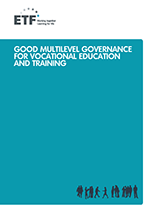Good multilevel governance for vocational education and training
 Good multilevel governance for vocational education and learning - Working paper
Good multilevel governance for vocational education and learning - Working paper
Introduction
The present working paper is based on analytical work conducted by the ETF in 2012 and broad consultation with ETF partner countries that included a pilot study (the study) on good multilevel governance in VET. The study was conducted in six partner countries, namely Azerbaijan, Croatia, Kazakhstan, Serbia, Tunisia and Ukraine, and its purpose was to map and assess the involvement of VET stakeholders across different functions of their national VET systems. The partner countries’ performance was then compared against a set of principles and indicators of good multilevel governance developed by the ETF1. The study was coordinated by the ETF Community of Practice on Governance, Partnerships and Regional Development. The results of the study, presented here, incorporate the key conclusions of the ETF corporate conference ‘Multilevel governance in education and training: challenges and opportunities’ that took place at the EU Committee of the Regions in Brussels from 31 May to 1 June 2012. During the conference the findings of the study were presented, and multilevel governance, including stakeholder participation as a means to enhance performance in VET, was discussed. Chapter 1 provides an overview of the key concepts and terminology related to governance, the rationale for ETF support of partner countries in good multilevel governance in VET, and the methodology adopted for the study. Chapter 2 presents the main findings of the pilot study on VET governance in the selected partner countries. Within the different policy areas investigated and based on cross-country analysis, the successes and gaps in both vertical and horizontal cooperation as well as the strengths and weaknesses in VET management are highlighted. In addition, this chapter introduces the key pilot results of testing ETF-proposed principles and indicators for good multilevel governance in VET. It is important to underline that this pilot study was essentially a reporting exercise with a limited scope, and that while the findings may provide a useful stimulus for further analysis and debate, they should not be seen as definitive research results. Nevertheless, the study offers useful in-depth information in a number of areas, leading to some preliminary conclusions. Chapter 3 suggests a number of areas on which policy makers and stakeholders could usefully focus, particularly the development of good multilevel governance to improve the effectiveness of VET. The conclusion summarises the key findings while identifying some trends, coordination mechanisms and ETF actions for building good multilevel governance in VET with partner countries. Finally, Annex 1 gives examples of successes and gaps in horizontal and vertical partnerships; Annex 2 introduces a roadmap for the development of good multilevel governance practice; and Annexes 3 and 4 reproduce the questionnaire used in the pilot study with a related glossary of terms used in the management of public policies in education and training. In summary, this report puts forward a number of questions and lines of action for policy makers to consider in ensuring that the governance of VET is fit for purpose.
1 For detailed information on the 2012 Torino Process, see the analytical framework for vocational education and training system reviews (ETF, 2012e).
Download Good multilevel governance for vocational education and learning.


/http%3A%2F%2F62e528761d0685343e1c-f3d1b99a743ffa4142d9d7f1978d9686.ssl.cf2.rackcdn.com%2Fassets%2Fcarlton%2Flogos%2Flogo-f060dceed298d13c6404ac7ff6f50db17e628d126e7fd75a6b81f5ff94f2a5fe.svg)
/http%3A%2F%2Fp3.storage.canalblog.com%2F36%2F28%2F1154600%2F99993054.jpeg)
/http%3A%2F%2Fwww.mpfm.fr%2Ftemplate%2Fmpfm%2Fimg%2Fentete%2Flogo.png)
/http%3A%2F%2Fwww.qaa.ac.uk%2F_catalogs%2Fmasterpage%2FQAADefault%2FQAALogo.png)
/https%3A%2F%2Fprofilepics.canalblog.com%2Fprofilepics%2F1%2F0%2F1076071.jpg)